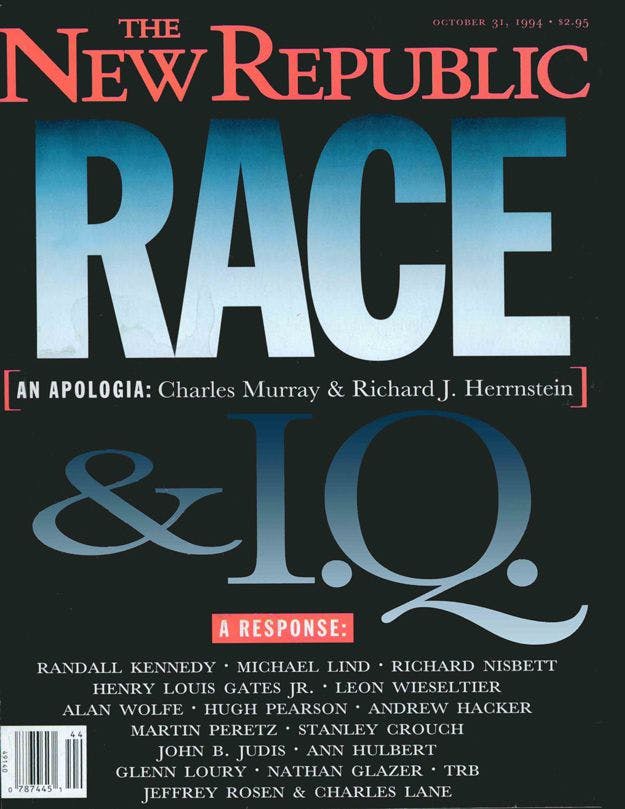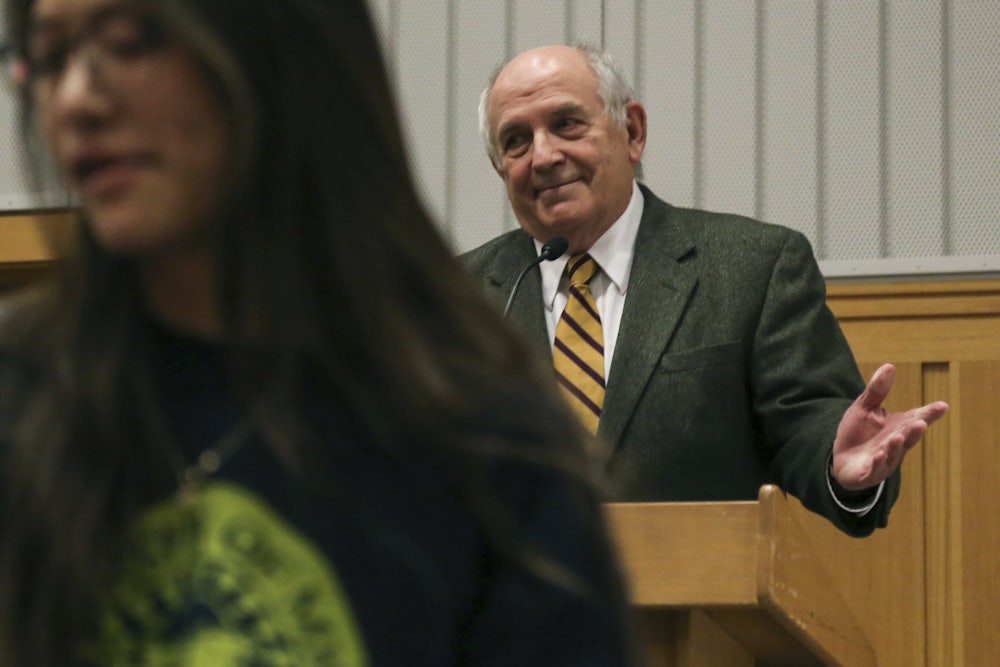In 1966, Nathaniel Weyl, a former communist who had become a National Review reactionary, went on a junket to Rhodesia, then a British colony ruled by a white minority that excluded the black majority from political power. During his visit, Weyl was provided data by the Rhodesian government that an unusually large number of white children there had stratospheric IQs of 180 or more. Weyl thus concluded that he had discovered a land of white geniuses.
“Thus, white Rhodesians are an elite element within the English-speaking world in terms of psychometric intelligence,” he wrote in the journal Intelligence. “Salisbury whites appear larger, healthier, more vigorous, alert and bright than London whites. Beatniks, transvestites and obvious homosexuals are conspicuously absent.”
Weyl hypothesized that “socialist Britain” was suffering a brain drain, with the best genetic stock heading for the hinterland of Rhodesia. “Obviously, punitive taxation of the successful, the imposition of economic hardship on young professionals, the underpayment of the creative elites and the over-payment of the subnormal and the mediocre will encourage some gifted people to emigrate and others to have small families while stimulating the exuberant reproduction of the intellectually under-endowed,” he wrote.
This screed is noteworthy because Weyl is one of the many eccentric, dubious sources who are cited as authorities in The Bell Curve, a controversial 1994 book about race and intelligence written by the Charles Murray and the late Richard J. Herrnstein. As Charles Lane pointed out in The New York Review of Books that year, the bibliography of The Bell Curve cites 17 scholars, including Weyl, who were editors or contributors at Mankind Quarterly, “a notorious journal of ‘racial history’ founded, and funded, by men who believe in the genetic superiority of the white race.”

The New Republic published an excerpt of The Bell Curve alongside criticisms of it by staffers, scientists, and intellectuals. More than two decades later, the book remains a polarizing topic in American public discourse, and has resurfaced again in an extensive argument between podcaster Sam Harris and Vox journalists Ezra Klein and Matthew Yglesias. Harris contends that Murray is “unfairly maligned” as as racist; Klein describes Murray as a “racial pessimist” and provocateur, while Yglesias calls him a “policy entrepreneur” whose “ideas are plain wrong.”
Klein and Yglesias do a superb job of debunking The Bell Curve, but don’t quite convey how strange the book is. As Yglesias rightly notes, the most controversial section of the book (the discussion of IQ differences between blacks and whites) is only a small part of the book’s argument and really not essential to the case Murray and Herrnstein were making. Most of The Bell Curve synthesizes entirely mainstream social science, but then pollutes it with cranks like Weyl and uses it to make entirely unfounded policy suggestions. “The actual conclusion of The Bell Curve,” Yglesias wrote, “is that America should stop trying to improve poor kids’ material living standards because doing so encourages poor, low-IQ women to have more children.”
More than a policy entrepreneur, Murray was—and remains—a marketing genius. Murray, then as now a scholar at the conservative American Enterprise Institute (AEI), realized that the best way to sell Murray’s Social Darwinist economic policy—which is more broadly anti-poor rather than just anti-black—was to foreground the racism, which would create controversy and appeal to people who would have little time for a dry statistical argument about the perverse incentive structure of the welfare state. As Yglesias argued, “promoting a heavily racialized view of the overall question of whether we should try to help poor families or punish them serves as a useful marketing gimmick for both books and legislation.”
Murray’s racialized argument is all the more stark because prior to The Bell Curve, he argued that focusing on racial difference was counterproductive to discussions of the welfare state. In a 1986 op-ed titled “Not a Matter of Race,” he wrote that “focusing on blacks cripples progress because explanations of the special problems facing blacks nearly all begin with the assumption that blacks are different from everyone else.”
This was in keeping with the larger argument of Murray’s first book, Losing Ground (1984): that the social pathologies of the American poor were rooted in government policy. But this environmental explanation, while also conservative, is in contradiction with The Bell Curve’s emphasis on hereditary traits. And the arguments of Losing Ground and The Bell Curve are also in contradiction with Murray’s later argument, in his 2012 book Coming Apart, that poverty in the white working class is caused by cultural factors.
In effect, Murray has published three books with radically different causal arguments, all of which come to the same conclusion (that the welfare state has to be gutted):
The main thing I didn’t get into was the oddity of Murray’s seemingly shifting rationales for reaching the same conclusion:
— Matthew Yglesias (@mattyglesias) April 10, 2018
Losing Ground is a perverse incentives theory, Bell Curve is genetic hierarchy, Coming Apart is cultural pathology. https://t.co/iGSogAUbyh
But of the three books, The Bell Curve was far and away most successful. It spent 15 weeks atop of the New York Times bestsellers list and, according to Eric Alterman in his 2003 book What Liberal Media?, outsold Losing Ground by a factor of ten.
Alterman wrote that “the amazing public relations achievement undertaken on behalf of the work by the formerly obscure Charles Murray” was “perhaps the most successful foray into the world of ideas by a combination of right-wing funders and their compatriot intellectuals.” In 1982, William Hammett, president of the Manhattan Institute, described Murray as a “nobody.” A dozen years later, Murray had a bestseller, thanks to hundreds of thousands of dollars in aid from think tanks like the American Enterprise Institute, which didn’t just fund Murray’s work but also made sure The Bell Curve was the book everyone was talking about. (The excerpt in The New Republic no doubt helped the book’s sales, too.)
Part of the sales pitch for The Bell Curve was that it offered forbidden knowledge: shocking discoveries by scholars like Weyl and other eugenicists that the mainstream media refused to acknowledge. (Harris titled his interview with Murray “Forbidden Knowledge.”) As Murray explained to The New York Times Magazine in 1994, the research for The Bell Curve “was a case of stumbling onto a subject that had all the allure of the forbidden. Some of the things we read to do this work, we literally hide when we’re on planes and trains. We’re furtively peering at this stuff.” Murray portrayed himself as a kind of pulp fiction hero—Robert Langdon, the protagonist of Dan Brown’s novel The Da Vinci Code, comes to mind—who uncovers dark secrets that the elites are hiding from the masses.
Meanwhile, a cynical publicity campaign aimed to keep The Bell Curve away from scholarly critics. As the Wall Street Journal reported, the book had been “swept forward by a strategy that provided book galleys to likely supporters while withholding them from likely critics.” The article noted that the American Enterprise Institute might have been trying “to fix the fight when it released review copies selectively, contrary to usual publishing protocols.” Citing this Journal article, Alterman added that “Murray and AEI also hand-picked a group of pundits to be flown to Washington at the think tank’s expense for a weekend of briefings by Murray and discussion of the book’s arguments. The strategy paid off when the book was released and the publicity machine put into action, long before the scientific establishment could garner a look and form any coherent judgment.” In effect, the marketing was designed the maximize the “allure of the forbidden.”
In his recent return to the limelight, Murray has displayed the same marketing genius he used to sell The Bell Curve, this time exploiting the popular anxiety about campus political correctness. On March 2, 2017, a talk given by Murray at Middlebury College, Vermont, was disrupted for 20 minutes by protesters, and Murray’s academic chaperon was assaulted by a protestor.
The attempted de-platforming of Murray was wrongheaded—and the violence committed was despicable—but it feeds into a false impression that his ideas are suppressed in society at large. Murray played into this false impression by using the Middlebury incident as a portend for a much larger cultural shift. In an essay reflecting on his experience at Middlebury, he warned that it could could become “an inflection point” if the protesters were not punished, otherwise “the intellectual thugs will take over many campuses.” “What happened,” he wrote, “has the potential to be a disaster for American liberal education.”
Once again, Murray displayed his gift for portraying himself as the center of a melodrama, a hero of truth under siege. And Harris seemed to buy into it.
“While I have very little interest in IQ and actually zero interest in racial differences in IQ, I invited Murray on my podcast, because he had recently been de-platformed at Middlebury College,” Harris told Klein on the latter’s podcast. “In my view, this seemed yet another instance of kind of a moral panic that we were seeing on college campuses.” He later added, “I came to think that [Murray] was probably the most unfairly maligned person in my lifetime. That doesn’t really run the risk of being much of an exaggeration there.”
Yglesias rightly condemned this “mythmaking,” noting that Murray has a perch at AEI, a voice in the Journal, and frequent, favorable coverage in the Times—not just from David Brooks, but the liberal Thomas Edsall. “Nobody has silenced or stymied him,” Yglesias wrote. “He is one of the most successful authors of policy-relevant nonfiction working in America today.”
Murray has brilliantly used his notoriety as a promoter of race science and rebranded himself as free speech martyr, thus developing a new audience of centrists and liberals who might not have agreed with the substance of his policy commitments. There’s a real sense in which that substance no longer even matters, as Murray is now famous for being famous—the ultimate goal of marketing.
